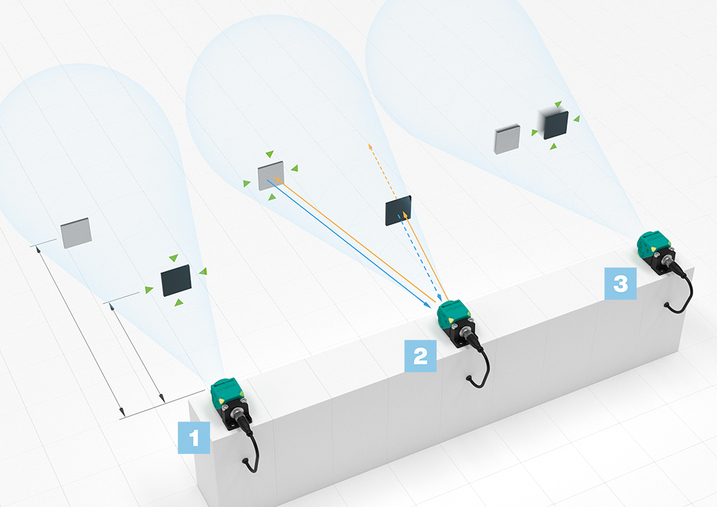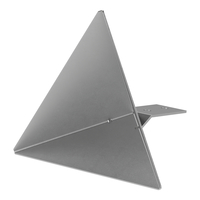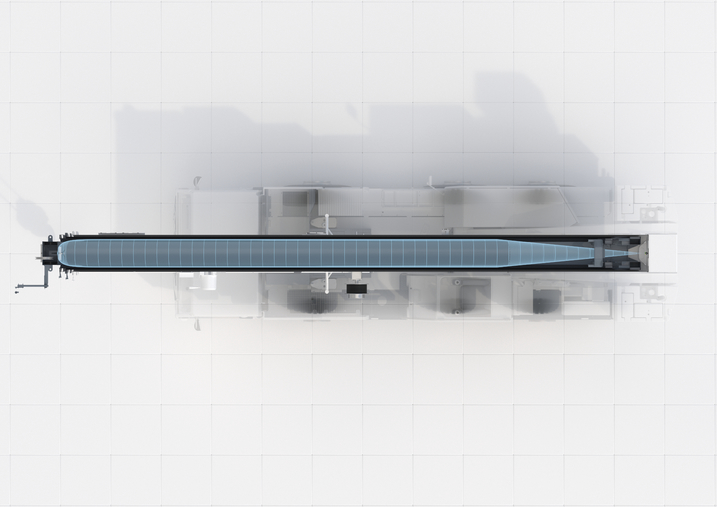Setup and Possible Applications of Radar Sensors
Reliable Detection under Adverse Conditions
Even under the most adverse conditions, industrial radar sensors from Pepperl+Fuchs deliver reliable measurement results. Whether rain, fog, wind, or dust—the operating principle of the electromagnetic wave is robust against challenging environmental conditions and extremely temperature-stable. In addition, the VariKont-L2 housing used has IP68/69 degree of protection. This combination of a low-interference operating principle and particularly robust sensor design means that a wide range of applications can be covered with just one device type, provided it is set up accordingly. Three different measurement modes are available for this purpose:

1. First Object: Material-independent detection of the object closest to the radar sensor
2. Best Reflection: Detection of the object with the best reflection properties, even through interfering objects
3. Fastest Velocity: Detection of the fastest object moving towards or away from the radar sensor
Example: Collision Avoidance and Limiting the Maximum Speed of Forklift Trucks

Due to the large detection range of the industrial radar sensors, various sections around forklift trucks can be reliably secured. The use of several radar sensors on one vehicle is possible without any problems, as the devices do not influence each other due to the frequency modulation used— without the need for a manually initiated synchronization process. In order to achieve optimum protection of the sections to be monitored, it is recommended to use the "first object" measurement mode. In this operating mode, the object closest to the sensor is detected regardless of the material. Depending on the speed of travel and the associated reaction speed, a high sampling rate is also required. This can be set via parameters up to a maximum of 200 Hz.
In addition to this, radar sensors can also be used to effectively reduce the maximum speed of forklift trucks: While high speed is still an advantage in outdoor areas and the surroundings are usually easy to see, a certain restriction is necessary inside plants and warehouses for safety reasons. A vertically aligned radar sensor, which detects the hall ceiling or metal cross struts below it, can be used to immediately determine when the forklift truck has reached an indoor area. If this is the case, the maximum possible speed is automatically limited to a tolerable level and only released again when the truck leaves the hall. Either "first object" or "best reflection" is recommended as the measuring mode. A high filter strength and a low sampling rate can be set to avoid unwanted speed reduction under crossbeams or bridges in the open field.
Penetration and Suppression of Materials
Materials without high electrical conductivity reflect and transmit electromagnetic waves. Reflections occur here at every transition (so-called matter jump), in the most frequent cases this is the transition from air to material and material to air. Absorption losses of the radar waves occur inside the material. If these absorption losses are rather low, as is the case with some plastics, the electromagnetic wave transmits through the material without high losses and emerges on the other side.
Example: Penetration of Tank Outer Layer

This ability of the radar wave to penetrate through various materials can be used to advantage in some applications. On the one hand, it can be used to create a visually appealing machine design by concealing sensors from view and protecting them from external influences behind a plastic plate. On the other hand, this feature can be used to measure the fill level in closed tanks, for example, without having to drill or cut a hole in the outer layer. The basic prerequisites here are that the measured medium has a high reflectivity and that the material properties of the tank or the point through which the sensor measures allow good transmission of the radar wave.
Measurements should be taken in the "best reflection" operating mode. Due to the multiple transitions from air to material and back again, the losses (material attenuation) can also lead to slight changes in the measured value, which, however, remain constant in the application if the material properties remain the same. If the level in the detection range of the sensor is limited, the minimum distance to the surface of the medium should be suppressed by a foreground suppression and the maximum distance of the sensor to the floor by a background suppression.
Corner Reflectors as Reference Targets and to Increase Reflection

Corner reflectors consist of three connected isosceles metal triangles. Due to their high reflectivity, even with angular deviations from the sensor, they are often used as reference targets for optimum range determination. If a corner reflector is attached to an object that is weakly reflective or not ideally aligned with the radar sensor, its reflective surface increases significantly. This makes it easy to stabilize measurements on the desired target object and optimize various applications as required.
Example: Distance Measurement in the Crane Arm

An exemplary application for the effective use of corner reflectors is the efficient support for the precise control of mobile crane booms. The radar beam of a radar sensor mounted inside the main boom is directed at a corner reflector positioned at the tip of the hydraulic telescopic boom. If the telescopic link moves forwards or backwards when the boom is extended or retracted, the sensor measures this change in distance and transmits the values to the crane's control system as a basis for further adjustment processes. As dirt deposits and residue from hydraulic oils make measuring difficult, the "best reflection" measurement mode is used to measure the corner reflector as a defined target object, as this provides a constant and stable reflection amplitude at all times.
However, it is also important to check other reflections in the sensor's detection range. This can be evaluated by recording up to ten reflections in one measuring cycle (distance values with reflection amplitude) using the "Reflections Array List". The alignment of the sensor to the reference target is crucial here in order to obtain a stable signal via the set operating mode. Ideally, the foreground suppression should also be set to the minimum distance between the sensor and the reflector in order to avoid faulty reflections.
Pepperl+Fuchs Hacks: Commissioning of Radar Sensors
In this video you will learn step by step how to integrate and parameterize the radar sensors from Pepperl+Fuchs within a CANopen engineering tool.









 +46 303 246070
+46 303 246070